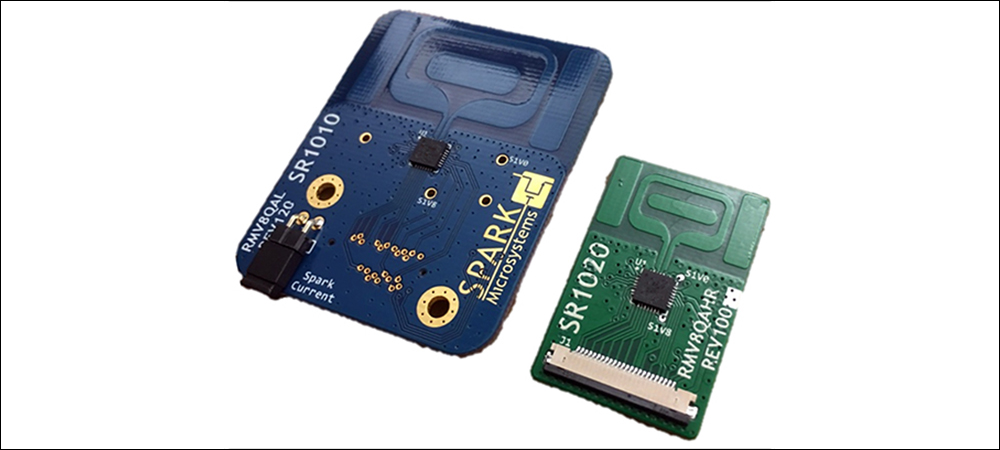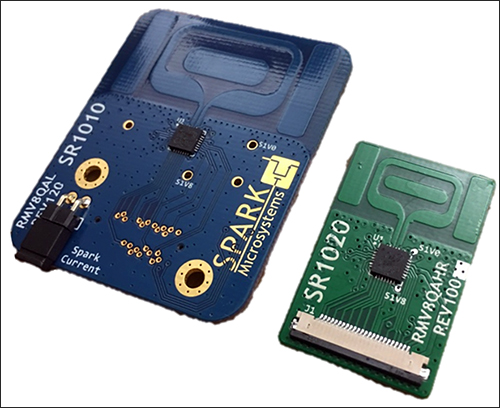Semiconductor company Spark Microsystems is releasing a series of ultra-wideband (UWB) ICs aimed at providing lost-cost, low-power wireless solutions for gaming, wearable devices and real-time locating. The company claims its SR1000 series ICs differ from other UWB chips on the market by requiring lower power and by offering the ability to avoid interference from other bands, such as those used for Wi-Fi.
The technology can provide high-quality, low-latency communications, resulting in a high data rate, the company says, as opposed to UWB solutions focused more on positioning data only. The chip comes in two versions: the SR1010 uses 3.1 to 6 GHz, while the SR1020 transmits at 6 to 9.3 GHz. Both have a data rate of 1 kbps to 10 Mbps for payload, while the over-the-air data rate can be 20 Mbps, using 1 milliwatt of power at 1 Mbps.
A system using the UWB technology would need to incorporate a Spark IC into both the transmitting and receiving UWB devices, and the company is now working with solution providers to begin building some of these systems. In fact, the firm has been sending evaluation kits to partners since last year, for UWB use in gaming, consumer devices and industrial applications. Spark Microsystems hopes partners will validate the technology, help build applications and create standards.
Spark Microsystems was founded in 2016, but its founders began researching low-power UWB ICs in 2009. The company had tested four new chips by 2016, released a beta version the following year and is now making its chips production-ready. In fact, the firm has received pre-production samples and plans to ramp up production around July 2020. “We offer ultra-low-power, ultra-low-latency technology,” says Fares Mubarak, Spark Microsystems’ CEO. The SR1010 offers up to 100-meter (328-foot) line of sight, while the SR1020 accomplishes 60 meters (197 feet). When compared against technologies such as Wi-Fi or Bluetooth Low Energy (BLE), he adds, Spark’s UWB system utilizes as much as 40 times’ lower power dissipation than BLE.
In addition to offering low power consumption, Mubarak says, the SR1000 transceivers can accomplish high data-rate communications, as well as using signals that are difficult to jam. Like other UWB products, the ICs utilize the total spectrum from 3.1 to 9.3 GHz. However, says Frederic Nabki, Spark Microsystems’ cofounder, they are designed to be less vulnerable to blocking by other transmissions, such as Wi-Fi.
The system can offer faster response times, Nabki reports, because the ICs do not need to be “started up” in order to transmit. “The advantage,” he states, “is you don’t need to wait for it to start up. You could synchronize fast and it can transmit data very quickly.” He says the system differs from other UWB solutions because it isn’t vulnerable to interference. “The Achilles heel of classic UWB is it’s sensitive to interference. Spark works hard on unique circuit- and system-level innovation to be impervious to interference.”
It does this, Nabki explains, by designing the radio to operate freely in a very wide spectrum. If someone were jamming the 4 GHz band, he says, Spark’s IC could detect the jamming in real time and move to another band. The chip comes with what he calls rejection circuitry, which ensure that the device can discriminate between a Spark communication and something else, such as Wi-Fi.
While UWB companies have expressed concern about Wi-Fi 6 blocking traditional UWB transmission bands, Nabki notes, Spark Microsystems feels that will not be a challenge for its ICs. “We embrace Wi-Fi 6 because we can co-exist,” he says. “We built the technology to coexist.” The ICs can either detect and avoid or detect and mitigate interference, Nabki adds. The SR1010 is coexisting with 5 GHz Wi-Fi today, he says, adding, “We are confident about SR1020 coexisting with upcoming Wi-Fi 6 GHz.” The chip can be used for location data, utilizing time of flight positioning, with up to 30-centimeter (11.8-inch) location accuracy at 110 meters (361 feet). But it is primarily designed to transmit data, including sensor information, audio and video streaming.
One immediate use case for the new ICs is in the wearable technologies market. A sensor attached to a patient could collect data such as oxygen level, heart rate or skin temperature, then transmit that information when interrogated by a Spark-enabled interrogator. Because it is so low in power, Nabki adds, it can send more than just a single stream of data. It could, for instance, transmit multiple sensor measurements or related data, such as audio or visual data. This, he says, can be done “without having milliwatts of power consumption,” meaning a small battery—even one using energy harvesting—might be sufficient.
On the other hand, it could work with an application such as gaming, for which a head-up display (HUD) could receive or transmit data, including video, audio and sensor information, regarding the movements of the person playing a game and wearing the head-mounted device. Additionally, a Spark chip could be embedded in a dongle that would manage high-speed data transmissions, including data to and from a microphone, mouse, keyboard or speaker. A company could put the necessary intelligence into its own software to manage the variety of data streams from that device.
In addition to gaming, the system could be used with smart homes and buildings (for security, smart appliances and smart assistants) and with mobile devices (wearables, body-area networks and peripherals). Users would need to have a Spark IC in both the receiver and transceiver, such as a smartphone. Although Apple announced UWB functionality in its handsets last year, the phones would require a Spark chip to work with Spark’s system. In the long term, Mubarak hopes to see that kind of adoption across the mobile phone sector, while in the shorter range, he says, the company expects solutions to be built for gaming or medical sensors, as well as for smart homes, buildings and factories, with the chip built into a dedicated gateway or interrogator.
The SR1000 chips each come with a UWB RF transmitter and receiver, a power management unit, a sleep counter and baseband hardware, as well as timers and a regulator. The microcontroller is external and can be attached to the IC via an SPI interface. In the future (potentially in 2022), the company expects to provide a product with the MCU built onto the chip. “I think that’s the natural progress,” Mubarak states, “and it will be important for some markets.” However, he adds, initial partners are more interested in building systems using the IC as a transceiver alone.
The next-generation IC will provide more granular location data, identifying a device within about 10 centimeters (3.9 inches) rather than the current version, which achieves 30 centimeters (11.8 inches) of location area. Power consumption for Spark’s UWB positioning functionality would be “significantly lower than other positioning UWB chips,” Mubarak notes.
Consumer-based deployments could include security and access control with a UWB key fob that would be detected at a parking gate, building entrance or vehicle. For health care, UWB-enabled hearing aids or implants could provide patient-monitoring information that could be collected by an UWB device. While the company is now deploying evaluation kits, it intends to reach a production-level release of its ICs during the second half of 2020.
The adoption of Spark ICs in smartphone handsets is part of the company’s end goal, Mubarak reports. However, he says, gateways using the Spark UWB technology can also communicate with a smartphone via Bluetooth and thereby make it possible for an individual to control the system with his or her phone. “You need to first have traction in the marketplace,” he says, as well as partners that build solutions. “We feel the future is moving in the direction of UWB.”





